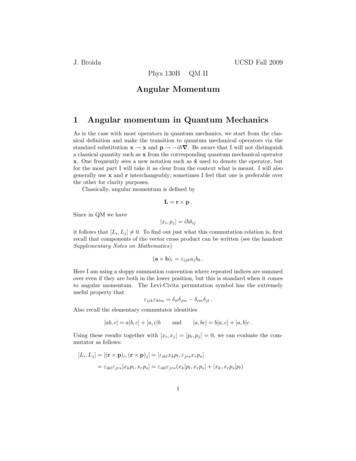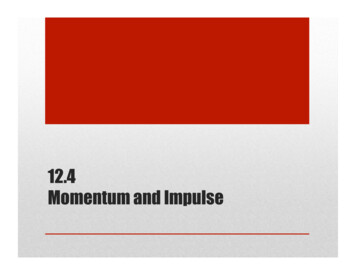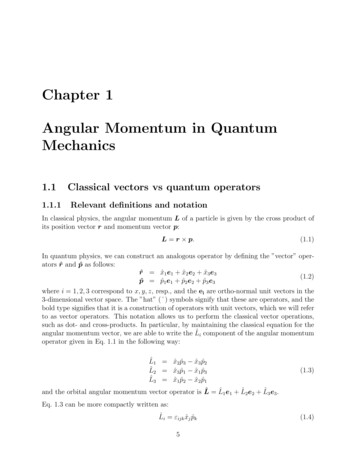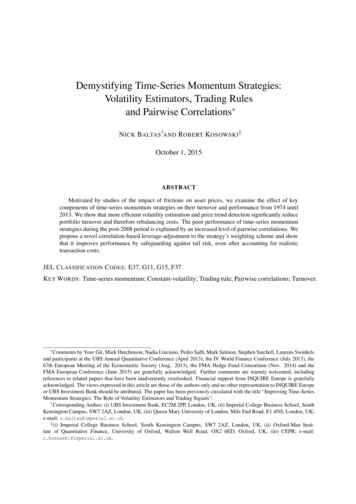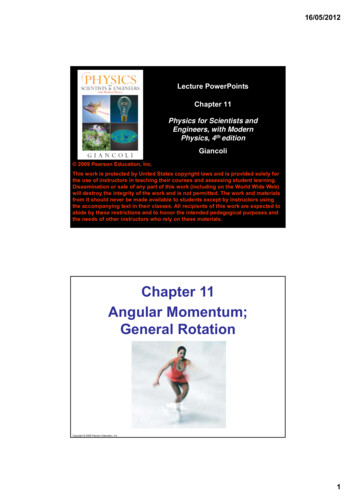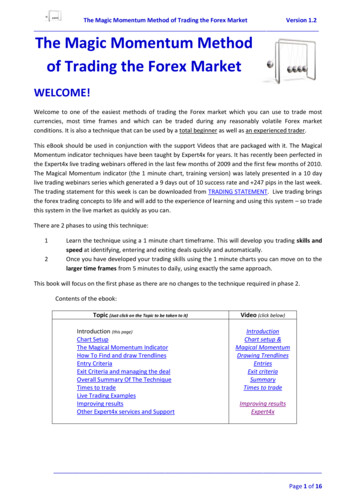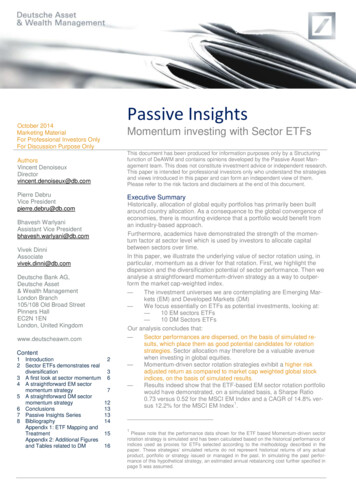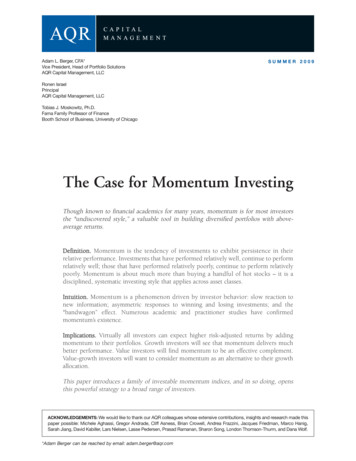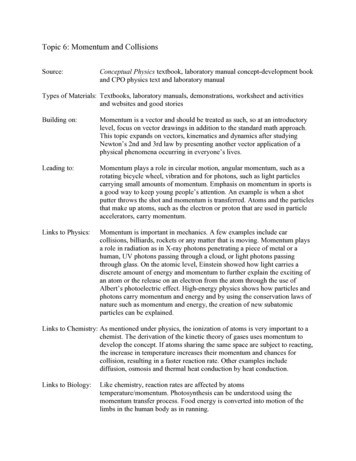
Transcription
Topic 6: Momentum and CollisionsSource:Conceptual Physics textbook, laboratory manual concept-development bookand CPO physics text and laboratory manualTypes of Materials: Textbooks, laboratory manuals, demonstrations, worksheet and activitiesand websites and good storiesBuilding on:Momentum is a vector and should be treated as such, so at an introductorylevel, focus on vector drawings in addition to the standard math approach.This topic expands on vectors, kinematics and dynamics after studyingNewton’s 2nd and 3rd law by presenting another vector application of aphysical phenomena occurring in everyone’s lives.Leading to:Momentum plays a role in circular motion, angular momentum, such as arotating bicycle wheel, vibration and for photons, such as light particlescarrying small amounts of momentum. Emphasis on momentum in sports isa good way to keep young people’s attention. An example is when a shotputter throws the shot and momentum is transferred. Atoms and the particlesthat make up atoms, such as the electron or proton that are used in particleaccelerators, carry momentum.Links to Physics:Momentum is important in mechanics. A few examples include carcollisions, billiards, rockets or any matter that is moving. Momentum playsa role in radiation as in X-ray photons penetrating a piece of metal or ahuman, UV photons passing through a cloud, or light photons passingthrough glass. On the atomic level, Einstein showed how light carries adiscrete amount of energy and momentum to further explain the exciting ofan atom or the release on an electron from the atom through the use ofAlbert’s photoelectric effect. High-energy physics shows how particles andphotons carry momentum and energy and by using the conservation laws ofnature such as momentum and energy, the creation of new subatomicparticles can be explained.Links to Chemistry: As mentioned under physics, the ionization of atoms is very important to achemist. The derivation of the kinetic theory of gases uses momentum todevelop the concept. If atoms sharing the same space are subject to reacting,the increase in temperature increases their momentum and chances forcollision, resulting in a faster reaction rate. Other examples includediffusion, osmosis and thermal heat conduction by heat conduction.Links to Biology:Like chemistry, reaction rates are affected by atomstemperature/momentum. Photosynthesis can be understood using themomentum transfer process. Food energy is converted into motion of thelimbs in the human body as in running.
Materials:(a) HewittLab 19 – Go CartLab 20 – Tailgated by a Dart(b) HsuLab 3A – Momentum and the Third Law(c) My LabsLinear Momentum on an Air Track (or Dynamics Carts)(d) WorksheetsHewitt – Concept-Development Book – 7.1 MomentumText (Chapter 7 Review – End of Chapter)Hsu3.1 & 3.3 in Text (Questions and Problems – End of Chapter)My WorksheetMomentum Worksheet/Activities(e) Demonstrations1. Jump from a Chair2. Happy and Sad Balls(f) Websites and Videos1. http://www.hazelwood.K12.mo.us/ grichert/sciweb/applets.htmlChoose pdf Physics Applets - www.walter-fendt.de/ph14e (Java 1.4) - Mechanics –Elastic and Inelastic Collisions. (You change the values, then calculate the kineticenergy before and after the collision and repeat for the momentum.)2. ESPN SportsFigures “Relaxing with Impulse” Video Guide (Football)3. Momentum in Collisions Lab Sims (Java)(g) Good Stories*
Topic 6: Momentum LabCollisions on an Air Track (or Dynamics Carts Colliding)Purpose: To observe and apply the conservation of momentum to elastic and inelastic collisions.(a) Elastic Collisions (with springs)Procedure: (After leveling the air track)1. Push one glider toward a second stationary glider of equal mass and write yourobservations for the:Moving glider –Stationary glider Explain why the gliders behave as they do.2. Push one glider toward a second stationary glider of greater mass and write yourobservations for the:Moving glider –Stationary glider –Explain why the gliders behave as they do3. Push one glider toward a second stationary glider of less mass and write yourobservations for the:Moving glider –Stationary glider –Explain why the gliders behave as they do.
4. Push a small glider toward a large glider that is moving at the same speed but inthe opposite direction.What happened?Which glider experienced the greater change in velocity?Which glider experienced the greater change in momentum?(b) Inelastic Collisions (without springs)Procedure:1. Push one glider without a spring toward a second stationary glider of equal masswithout a spring, but with clay attached to the end of one or both of the glidersand write your observations for the:Moving glider Stationary glider –Explain why the gliders behave as they do.2. Push two equal mass gliders at each other at equal speeds. One glider should haveclay attached to an end and the second glider could also have the small piece ofclay. Explain why the gliders behave as they do.
Topic 6: Momentum Worksheet/Activity (D)Momentum is defined as a mass moving, or mv. V is a vector so momentum is a vector, withmass being a scalar. In the SI measuring system, mass is measured in kilograms (kg) and velocityis in units of (m/s), so momentum is measured in units of kg m/s, or p is in units of kg m/s.Example: Consider a 2 kg ball moving north at 3m/s. Its momentum is 6 kg m/s going north.Impulse: Since we have discovered that F MA and A !V / !T, we get F M!V / !T. So,F!T M!V.Putting this in words, the equation says: The impulse (force times the time of acting) given to abody changes its momentum by the same amount.Activity/Demonstrations:Meter Stick(A)(B)A.Cross Bar20 cmRod80 cm200 gTableApparatus: Insert two table support rods into a lab table (or make a tripod support pole verysecure). Attach a horizontal cross bar. Clamp about 20 cm of a meter stick to thecross bar (see sketch), leaving 80 cm free to move up and down. Make two 20 cmloops of thread and attach 200 g to each loop.Procedure/Discussion:1. Place one loop over the free end of the meter stick until about 10 cm from the endof the cross bar.2. Lift the weight by the thread until the weight almost touches the meter stick. Use a cleanrelease to drop the weight around 10 cm from the end of the cross bar (A).3. (a) What occurred?
(b) Why?4. Repeat procedures 1 and 2 using the second loop and weight, but this time near the end ofthe meter stick (B).5. (a) What resulted?(b) Why?B. Throw a raw egg into the center of a bed sheet that is held by two students as shown in thesketch.SheetHave two students get a GOOD grip on the corners of the sheet to form a vertical letter J (seesketch). After the “hit,” make the J into a U so the egg doesn’t roll out.Explain the outcome.
What would have happened if you through the egg into a brick wall? (Please don’t do!)Explain the wall/egg outcome.Conservation of Momentum:The conservation of momentum is a result of Newton’s 3rd law. A standard approach to theconservation derivation is as follows:MM1M2Two spheres, M1 and M2, approach each other along a straight line with velocities V1 and V2respectfully. According to Newton’s 3rd law, a pair of equal forces exists between the twospheres at the same time, but in opposite directions, thus,F 2,1F1,2MMMass 1 feels a force of mass 2 on it (called F2,1) but opposite to the force on mass 2 causedby mass 1 (called F1,2) so F2,1 is ( - ), or in the opposite direction, compared to F1,2.Since F MA, and –F2,1 F1,2,Giving –M1A1 M2A2, so, -M1!V1 / !T1 M2!V2 / !T2,And the times of impact are equal on each sphere (!T1 !T2),Thus, -M1!V1 M2V2.In words, the loss in momentum of mass 1 is equally gained by mass 2. Placing the negativesign on the other side of the equation says mass 1 gains momentum that was lost by mass 2(THE CONSERVATION OF MOMENTUM).
Or, rewriting, 0 M1!V1 M2!V2.Which says that the total change in momentum is zero, or that the total momentum doesn’tchange—or MOMENTUM IS CONSERVED!!!This could be written as 0 !p1 !p2, saying again, momentum is conserved.C. Newton’s Cradle – Try pulling back one sphere and releasing.What happened?Explain using the conservation of momentum.D. Go to the websites in the ARISE presentations and load Java,http://www.java.com/en/index.jsp, and do Momentum in Collisions Lab Sim (Java).Summarize your findings:
Topic 6: (e) Demonstrations – Momentum and Collisions1. Jump from a ChairPurpose:To conceptually view impulse and momentum transfer.Procedure: Stand on a sturdy chair (be careful) and tell the class you are going to jump andkeep your legs straight and your knees locked. Ask: Is that OK with you? Mostwill say don’t do it! Others will say go right ahead and let’s see what happens.Jump, but bend your knees upon impact and say that due to my greatunderstanding of physics, I choose to bend my knees!Ask:Why do I bend my knees?Answer:Do this demo after talking about impulse or as a lead in to impulse, since F !t m !v.And the change in momentum is the same whether one keeps his/her legs straight or bentupon impact (the starting velocity and the impact velocity are the same); the impulse is thesame for both ways. Since impulse is F ! t, one can alter the force with the knees locked orbent. So bending the knees reduces the average force, as the time of impact is much longer,thus you don’t break your legs!!LockedF!tBent F!t2. Happy and Sad BallsPurpose:This, like the jumping from the chair, conserves momentum but modifies thetime and thus the force of impact.Procedure:Hold these spheres high above your head at equal heights. Ask students toobserve and explain. Drop them and observe that one rebounds as an elasticrubber ball and the second goes thud.
Explanation: They look the same but the molecular make-up is different to change theelasticity of the nonbouncy ball—it hits like a brick! Therefore, we haveagain,F !tSad – nonbouncy F!thappy - bouncy
and CPO physics text and laboratory manual Types of Materials: Textbooks, laboratory manuals, demonstrations, worksheet and activities and websites and good stories Building on: Momentum is a vector and should be treated as such, so at an introductory level, focus on vector drawings in addition to the standard math approach. This topic expands on vectors, kinematics and dynamics after studying .
